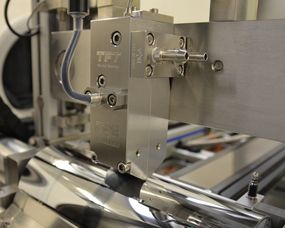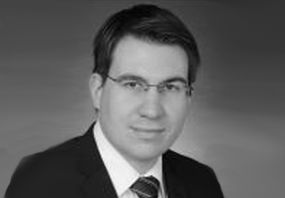![[Translate to English:] Fotocollage](/fileadmin/_processed_/3/f/csm_Printing_TFT_Group_Title_1235ed2bbc.jpg)
THIN FILM TECHNOLOGY
Investigation of single- and multilayer deposition via slot die coating. After processing the layers, they are characterized with regard to film homogeneity, edge effects etc.
Karlsruher Institut für Technologie (TFT)
The Thin Film Technology (TFT) group at KIT is working on coating and drying of thin films and is headed by Prof. Wilhelm Schabel and Dr. Philip Scharfer.
Our research focuses on:
- self-dosing film applications (knife coating, spin-coating)
- pre-metered coating methods (slot-die coating)
- coating of homogenous single- and multi-layers for organic light-emitting diodes (OLEDs) and organic photovoltaics (OPV)
- drying of functional films

At InnovationLab, we investigate single- and multilayer deposition via slot-die coating. After processing the layers, they are characterized with regard to film homogeneity, edge effects, etc. in Heidelberg. Therefore, a special high precision slot-die coater was constructed which is now operated by TFT. This high precision slot-die coater consists of a coating module as well as an in-house developed comp nozzle dryer which is optimized for batch coating applications.
At the moment, structured coatings such as stripe coating are investigated. A further field of current research efforts is the determination of optimized drying conditions for different materials.
Coating of Homogeneous, Large-Area Layers
For organic electronics, highly homogenous layers are required. By optimizing coating conditions we aim at understanding defect mechanisms during film deposition for further defect elimination. Therefore, we investigate:
- The influence of fluid properties on coating stability and quality.
- Process windows to obtain stable coating conditions.
- Why edge effects arise and how can they be reduced?
- Is there a possibility for a scale-up of the process towards the industrial scale?
Drying of Homogenous Large-Area Layers
The coating step is always followed by a drying process to remove the solvent during which the properties of the functional film develop. By controlling the drying process the desired film morphology can be adjusted. Due to the measurement of phase equilibria and drying kinetics, models for the drying process can be developed. The focus is on:
- The control of drying kinetics and drying times (as these are very cost-intensive).
- Realization of the homogenous drying of the films.
- How can film morphology be controlled by drying conditions?
- Residual solvent contents in thin films.
Development of Multilayer Concepts
Besides the investigation of single layers, the development of multilayer deposition concepts is very crucial for organic electronics. The results from single layer experiments are transferred to multilayer experiments in order to investigate the simultaneous application of several layers in one step. The challenges are:
- Can intermixing between the layers be prohibited?
- How can layers be applied simultaneously?
- Which concepts can be transferred to the industrial scale?
Coating lines: High precision slot die coater (S2S) and R2R pilot plant
At InnovationLab we run a sheet-to-sheet (S2S) table slot die coater which was built in cooperation with TSE Troller AG (Switzerland). It offers the possibility to coat on a table as well as on a roll. Besides single layer experiments, two layers can be coated in one step with a dual-layer slot die. An in-house developed dryer was installed to ensure homogenous coating conditions after the deposition step. Continuous coatings on a roll-to-roll (R2R) are possible in our coating lab at KIT. The first promising results state that slot die coating is applicable for the high-throughput fabrication of highly efficient OLEDs.
Simulation
Our research is based on calculations and simulations on the one hand and their experimental verification on the other hand. With the help of CFD programs we improve the fluid flow in our coating apparatus and our drying equipment. During the past years, several models were developed and are continuously improved to predict the relevant coating and drying steps. With the help of the established routines, plants at an industrial scale can be designed. The required material properties have to be measured in advance in our characterization lab.
Magnetic sorption balance
For the determination of thermodynamic phase equilibria, we use a magnetic sorption balance. The knowledge of phase equilibria is essential for all models and predictions of drying times and diffusion. With the help of a magnetic sorption balance, sorption and desorption experiments are performed to investigate diffusion in thin films. Currently, the influence of the substrate on the diffusion of solvent in thin polymeric films is investigated.
Raman spectroscopy
With Raman spectroscopy, the local composition of films in the micrometer-range can be measured in-situ during drying experiments. This allows us to determine diffusion coefficients in binary and multilayer systems. Interdiffusion of polymeric films can be measured as well. It is a powerful tool for verifying our models and simulations.

Ralf Diehm, Dipl.-Ing.
Contact via Email
Topics: Intermittent slot die coating

Tobias Fritzensmeier, M. Sc.
Contact via Email
Topics: Diffusion in nanometer-thin layers

Lisa Merklein, M. Sc.
Contact via Email
Topics: Multilayer OLED Processing, Interdiffusion, Slot die Coating (HOPSI)

Anna-Lena Riegel, Dipl.-Ing.
Contact via Email
Topics: Biosensors

Max Toensmann, Dipl.-Ing.
Contact via Email
Topics: Drying defects, Marangoni convection
